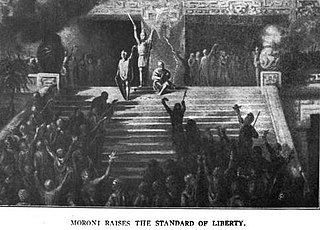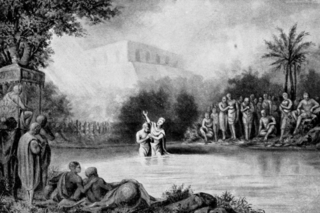
The Book of Alma: The Son of Alma, usually referred to as the Book of Alma, is one of the books that make up the Book of Mormon. The title refers to Alma the Younger, a prophet and "chief judge" of the Nephites. Alma is the longest book in the Book of Mormon and consists of sixty-three chapters, taking up almost a third of the volume.
The Book of Omni is one of the books that make up the Book of Mormon, a text that the Latter Day Saint movement regards as scripture. The book is written as the combined composition of several authors, the first of whom, Omni, provides the name of the book. According to the narrative, the book covers more than two centuries of Nephite history within one chapter of text. It refers to wars between the Nephites and Lamanites, the reign of Kings Mosiah and Benjamin, and their participation in the wars and journeys through the wilderness.
The Book of Ether is one of the books of the Book of Mormon. It describes the Jaredites, descendants of Jared and his companions, who were led by God to the Americas shortly after the confusion of tongues and the destruction of the Tower of Babel. Ether consists of fifteen chapters.
The Second Book of Nephi, usually referred to as Second Nephi or 2 Nephi, is the second book of the Book of Mormon, the primary religious text of the Latter-day Saint Movement. Narrated by Nephi, son of Lehi, unlike the first Book of Nephi, 2 Nephi contains little history of the Nephite people and focuses predominately on visions and prophecies of Nephi himself and other prophets, particularly Isaiah.

The Book of Mormon mentions three men named Helaman. The first was the son of King Benjamin, king of the united Nephite-Zarahemla kingdom who lived in the 2nd century BC. Besides his genealogy, information about the first Helaman is limited. His brother, Mosiah, became heir to the throne.

Zarahemla is a land in the Book of Mormon that for much of the narrative functions as the capital of the Nephites, their political and religious center. Zarahemla has been the namesake of multiple communities in the United States, has been alluded to in literature that references Mormonism, and has been portrayed in artwork depicting Book of Mormon content.

Mormon is believed by members of the Church of Jesus Christ of Latter-day Saints to be a prophet-historian and a member of a tribe of indigenous Americans known as the Nephites, one of the four groups described in the Book of Mormon as having settled in the ancient Americas.

According to the Book of Mormon, the plates of Nephi, consisting of the large plates of Nephi and the small plates of Nephi, are a portion of the collection of inscribed metal plates which make up the record of the Nephites. This record was later abridged by Mormon and inscribed onto gold plates from which Joseph Smith translated the Book of Mormon after an angel revealed to him the location where the plates were buried on a hill called Cumorah near the town of Palmyra, New York.

According to the Book of Mormon, Amaleki was one of several Nephite record keepers who maintained records on metal plates known as the plates of Nephi. The Book of Mormon refers to the small plates of Nephi and the large plates of Nephi. Nephi began writing on the small plates about 570 BC. Nephi's brother Jacob and his descendants began keeping records of sacred and religious matters on the small plates around 544 BC. Seven of Jacob's descendants, including Amaleki, wrote on the plates. Amaleki recorded his account on the plates about 130 BC. He states at the end of his writings that the plates are full. He received the plates of Nephi from his father Abinadom and penned 18 verses in the Book of Omni. He was the last person to write in the small plates of Nephi. Having no descendants, Amaleki gave the small plates to King Benjamin.

According to the Book of Mormon, Nephi, along with his brother Lehi, was a Nephite missionary. His father was Helaman, and his sons include two of the twelve Nephite disciples at the time that Christ visited the Americas.
This chronology outlines the major events in the history of the Book of Mormon, according to the text. Dates given correspond to dates in the footnotes of the Church of Jesus Christ of Latter-day Saints edition of the Book of Mormon and to a Jaredite timeline proposed by Latter-Day Saint scholar John L. Sorenson.

In the Book of Mormon, Mosiah, King Benjamin's son and Mosiah I's grandson, is king of the Nephite nation from about 124 BC to 91 BC. The Book of Mosiah is named after Mosiah. Mosiah is also a prophet and is described by Ammon as a "seer" who can translate records.
In the Book of Mormon, Zenock is a prophet who predates the events of the book's main plot and whose prophecies and statements are recorded upon brass plates possessed by the Nephites. In the narrative, Zenock is a descendant of Joseph, and he is also an ancestor of the Nephites. Narrators of the Book of Mormon and Nephite prophets quote or paraphrase Zenock several times in the course of the text, including Nephi, Alma, son of Alma, Amulek, Nephi, son of Helaman, and Mormon. Zenock's teachings as referenced in the Book of Mormon include prophesying about the Messiah, describing his death and aligning that with something that Mormons believe is like the Christian doctrine of salvation, and rebuking people who reject that message. In the Book of Alma, Alma reports that Zenock was stoned to death for preaching that the Messiah would be the "Son of God."

There are a number of words and phrases in the Book of Mormon that are anachronistic—their existence in the text of the Book of Mormon is at odds with known linguistic patterns or archaeological findings.

Mosiah priority is a theory about the creation of the Book of Mormon arguing that the original manuscript began not with 1 Nephi, but midway through, starting with Mosiah. According to Mosiah priority, after the text of Mosiah through the end of the Book of Mormon was transcribed, Joseph Smith returned to the beginning and transcribed 1 Nephi through Words of Mormon. Mosiah priority is the most widely held solution to questions regarding the sequence of the English text.

The following outline is provided as an overview of and topical guide to the Book of Mormon:





